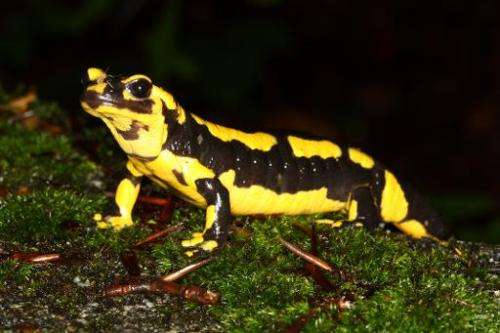Europe's salamanders at risk from mystery fungus

The discovery of dozens of dead salamanders in Belgium in recent weeks is triggering fears that a mystery fungus risks threatening the very survival of the tiny amphibians across Europe.
Spotted for the first time in the Netherlands in 2008, the fungal infection has killed off 96 percent of that country's terrestrial or fire salamanders.
Authorities there have had to place survivors in protected environments in zoos to ensure the survival of the species, said the Belgian nature protection group Natagora.
The infection was thought to be restricted to the Netherlands until the discovery in April of dozens of salamander corpses in a southern Belgian forest, as well as similar though as yet unconfirmed reports now coming from southern Germany.
"The situation is worrying for the European terrestrial salamander," Francks Pasmans, director of the laboratory for veterinary bacteriology and mycology at the veterinary medicine faculty in Ghent, told AFP.
He said it was "only a question of time" before the spread to France of Batrachochytrium salamandrivorans, the fungal disease that has resulted in the serious decline and extinction of almost 200 species of amphibians worldwide and which some say is posing the greatest threat to biodiversity of any known disease.
The yellow-spotted terrestrial salamander, known as salamandra salamandra, was once thought to be able to endure fire and was taken by French Renaissance King Francois I as his emblem.
The fungal infection causes erosive skin disease, killing the salamanders in two weeks by suffocation.
Natagora director Philippe Funcken said the infection, transmitted by contact or in the water "is progressing by several dozen kilometres each year".
Scientists still lack data on the origins of the disease and its potential harm to other animal species.
Some believe that international trade in amphibians, notably for laboratory tests, may be responsible.
"One hypothesis is that it might come from the United States or Asia where it caused no harm as local species had adapted to it," Pasmans said.
Another killer fungal infection, Batrachochytrium dendrobatidis, is held responsible for the extinction of some 200 amphibian species in Central America and Australia.
That infection reached Europe some 15 years ago but appears to be on the wane, Pasmans said.
For now scientists are recommending that people wash and disinfect shoe-soles after walking in the woods to avoid spreading the fungus further.
But Pasmans says the time appears to have come for a Europe-wide action campaign.
© 2014 AFP


















